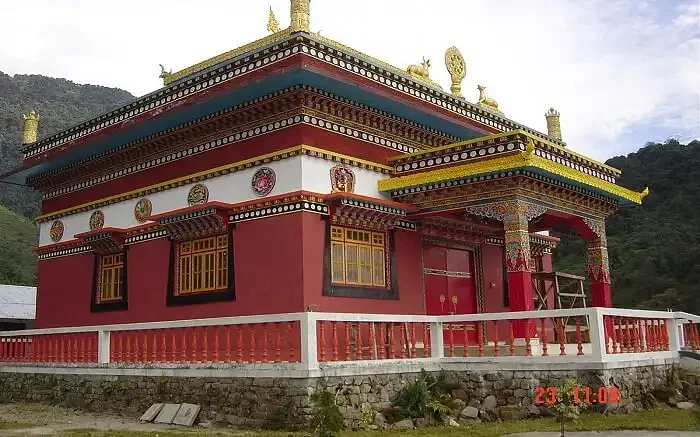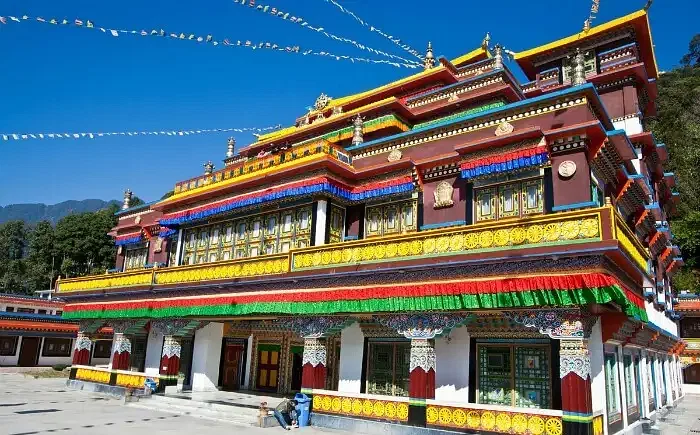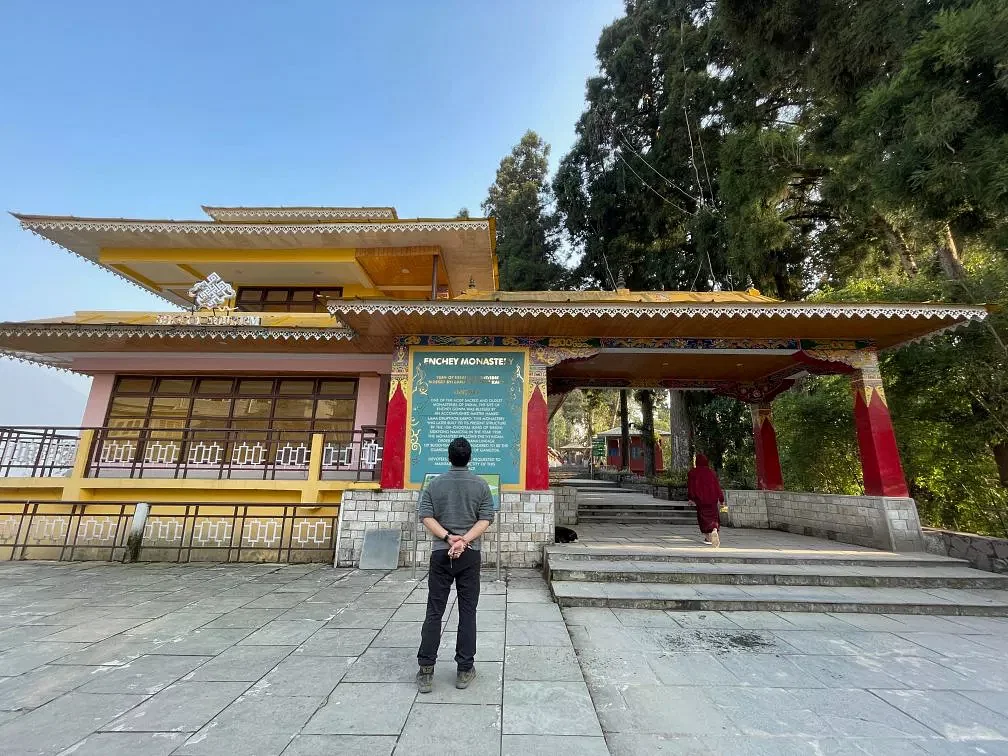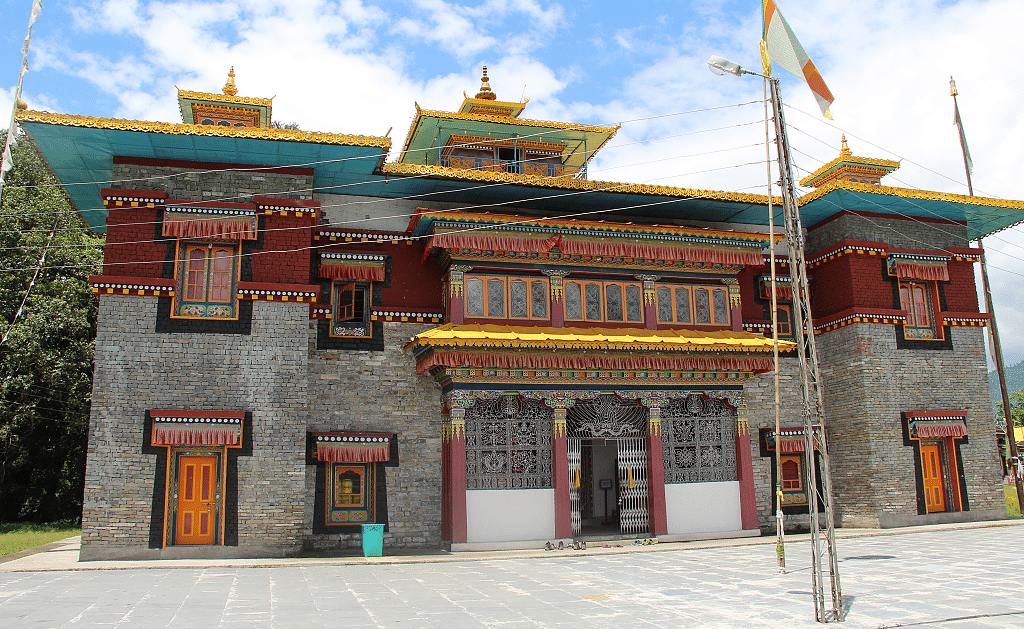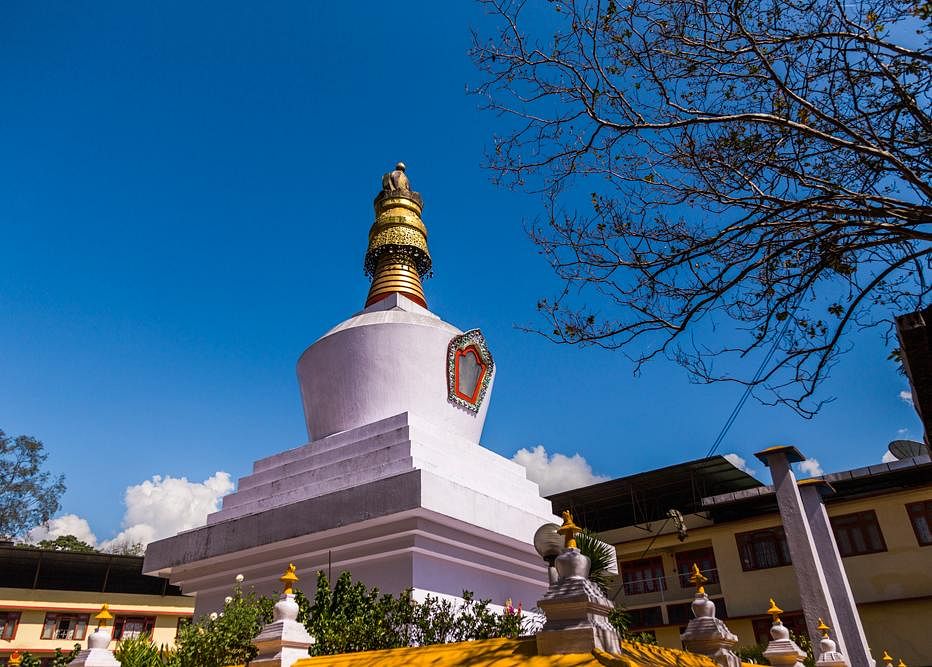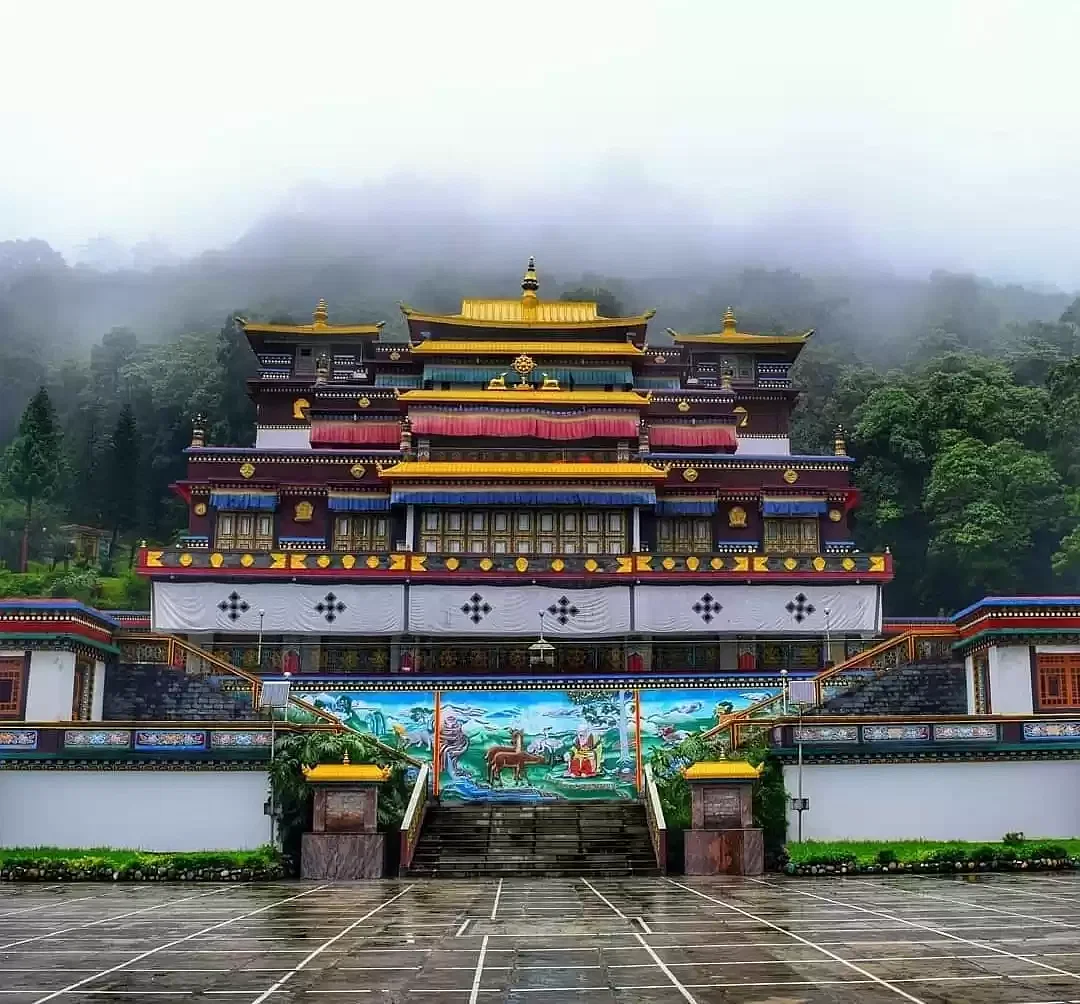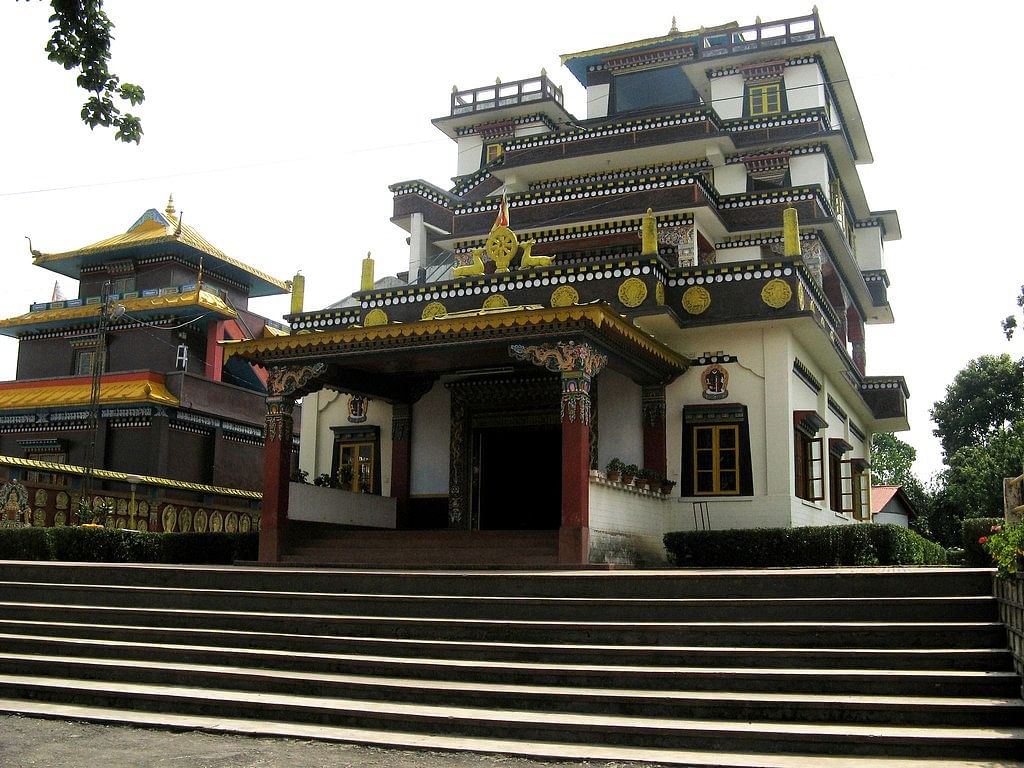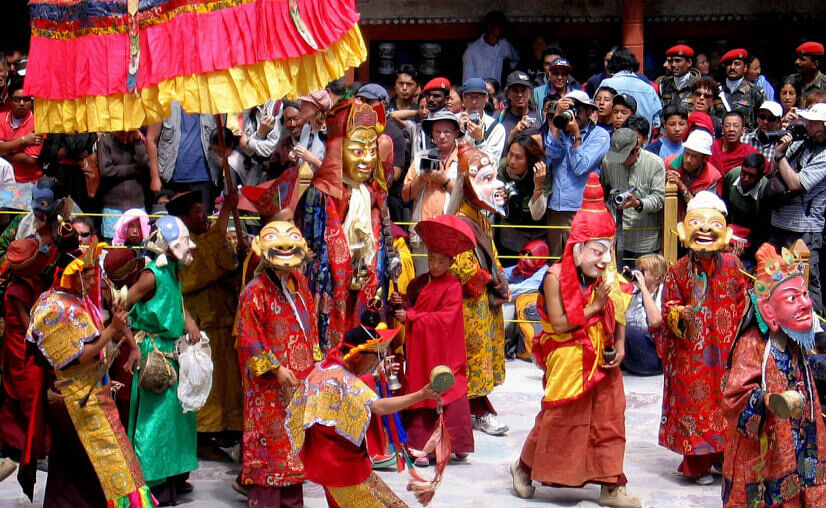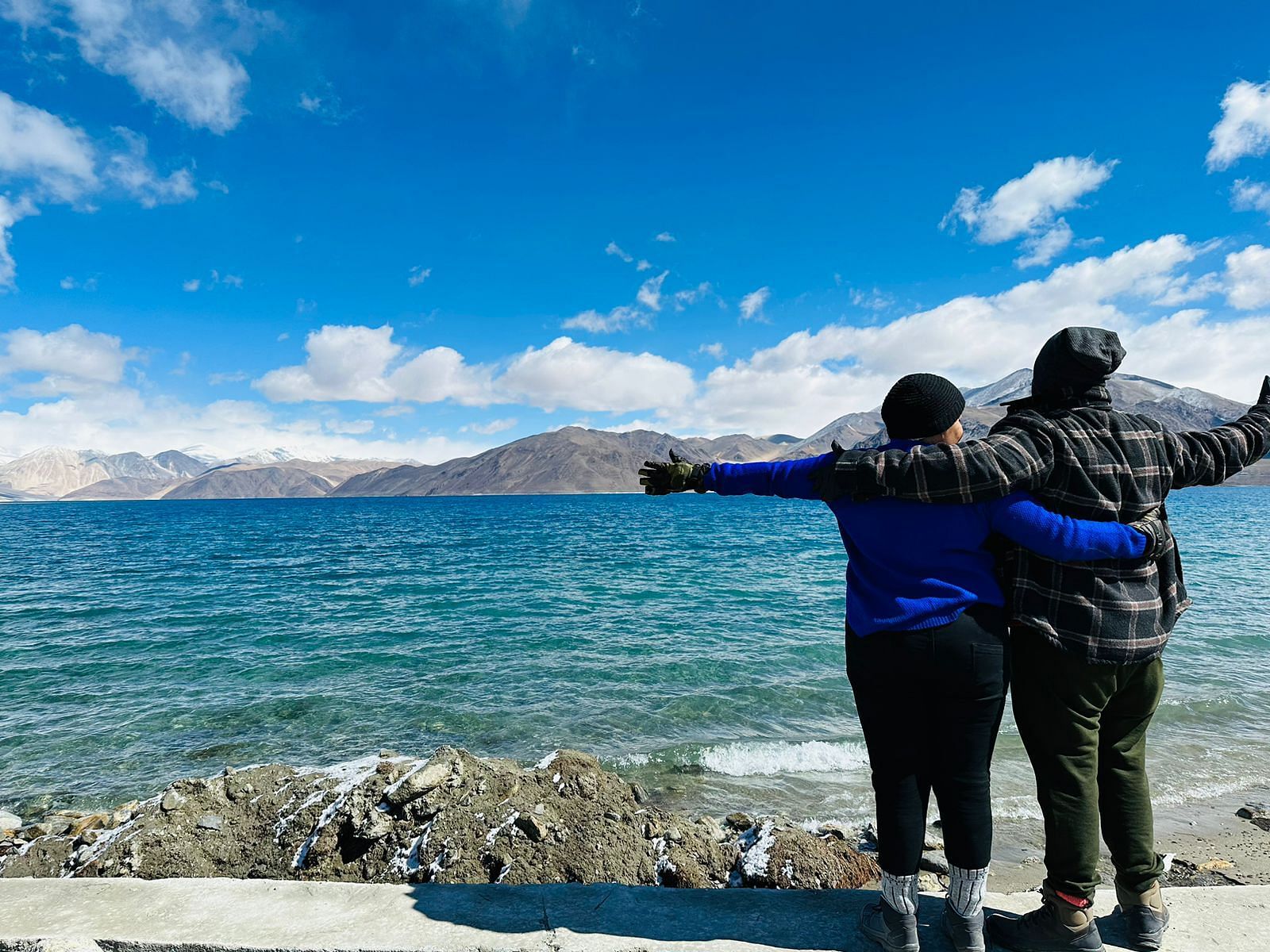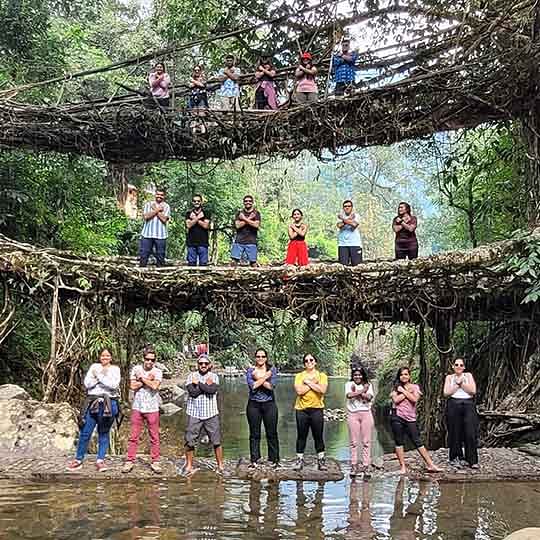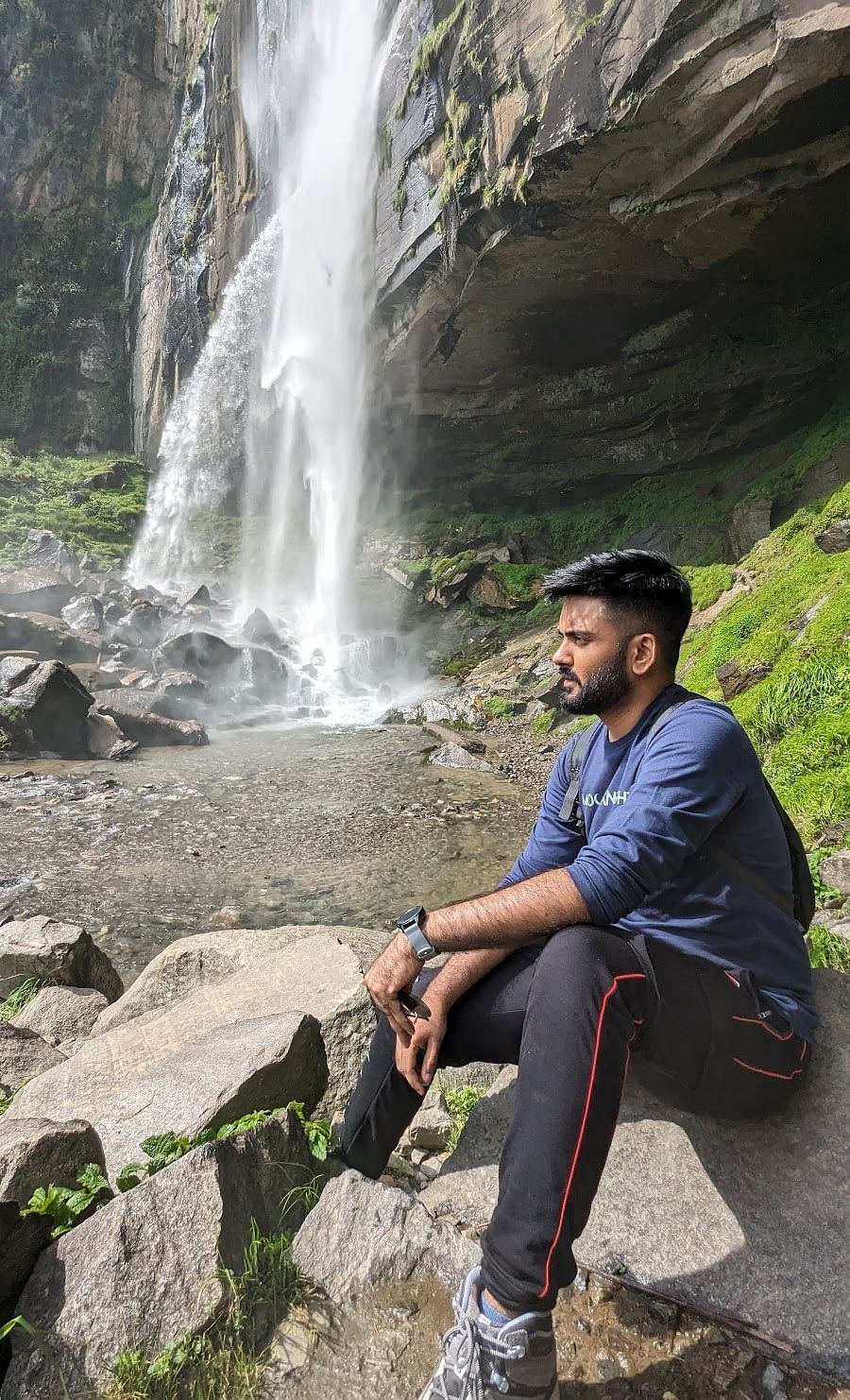If you think that scenic monasteries, pine forests, alpine lakes, high-altitude meadows, and the scenic Himalayas can only be found in Himachal Pradesh, then you have probably not heard of the northeastern state of Sikkim which you can explore with our Best Sikkim Trips!Along with the several things to do in Sikkim‘s natural beauty, the monasteries in Sikkim are also worth exploring! Nestled between Nepal, Bhutan, and Tibet, Sikkim is a cultural and natural treasure trove waiting to be explored.
Get ready for the spiritual adventure in Sikkim, as we take a virtual trip to the best monasteries to visit in Sikkim. This stunning state is home to over 200 monasteries, each a masterpiece of Tibetan, Chinese, and Indian architecture.
Imagine yourself surrounded by breathtaking vistas, colorful prayer flags, fresh mountain air, rare art treasures, and centuries-old prayer wheels, and feel the sense of peace in these sacred spaces, where Buddhist monks and nuns practice ancient traditions! Such is the beauty of the top monasteries of Sikkim.
Discover the rich cultural heritage of Sikkim’s diverse communities – Nepali, Bhutia, and Lepcha. Let the unspoiled natural beauty of this Indian state leave you awestruck! Whether you’re a history buff, a culture vulture, or a seeker of peace, the best monasteries of Sikkim will captivate your senses and leave you spellbound.
So why wait? Embark on a journey to the monasteries in Sikkim and uncover the secrets of this Himalayan paradise!
11 Famous Monasteries of Sikkim
Location: Ranipool-Rumtek-Sang Road, Rumtek, Gangtok – 737135History and Architecture: Rumtek Monastery, also known as the Dharmachakra Centre, is one of the Best monasteries in Sikkim and one of the top places to visit in Gangtok. It was originally built in the mid-18th century by the 9th Karmapa but was later reconstructed in the 1960s by the 16th Karmapa after fleeing Tibet.
The monastery showcases traditional Tibetan architecture with its vibrant colors, intricate murals, and golden statues. The large prayer hall, adorned with beautiful thangkas and a 10-foot-high statue of Guru Rinpoche, is a sight to behold.
Cultural Significance: Rumtek Monastery is the seat of the Karmapa Lama, the head of the Karma Kagyu lineage of Tibetan Buddhism. It’s a center of Buddhist learning and spirituality, attracting monks and visitors from around the world.
As one of the Best monasteries in Sikkim, it’s a must-visit destination for anyone interested in Tibetan culture and religion. The monastery is also known for its annual masked dance festival, Tse-Chu, which is a vibrant and colorful celebration of Tibetan culture and religion.
Location: 8742+3JP, Gyalshing district, Sikkim 737111History and Architecture: Pemayangtse Monastery, founded in 1705 by Lama Lhatsun Chempo, is one of the oldest and the Best monasteries in Sikkim and also the most revered monasteries in Sikkim. The name “Pemayangtse” means “Perfect Sublime Lotus,” reflecting its spiritual significance.
The monastery features stunning traditional Tibetan architecture with beautifully painted walls and statues. Its highlight is the seven-tiered wooden structure depicting the heavenly abode of Guru Rinpoche, which is intricately carved and painted.
Cultural Significance: As one of Sikkim’s most important monasteries, Pemayangtse plays a crucial role in the state’s religious life. It belongs to the Nyingma sect of Tibetan Buddhism, the oldest of the four major schools.
The monastery is a hub of spiritual activities and hosts several important festivals, including Losar, the Tibetan New Year. The peaceful surroundings and spiritual ambiance make it a must-visit for anyone interested in Buddhism and Sikkimese culture.
Location: 8JP9+9MF, Gangtok, Sikkim 737103History and Architecture: Enchey Monastery, situated on a hilltop overlooking Gangtok, was established in 1909 by Lama Drupthob Karpo, known for his flying powers. This sacred site is believed to be blessed by his spiritual energy. Enchey Monastery is one of the Best monasteries in Sikkim. Soaking the surrounding view of Gangtok is one of the top things to do from the Enchey Monastery.
The monastery features stunning Tibetan architecture with vibrant prayer flags, colorful murals, and ornate prayer wheels. The main prayer hall is adorned with images of Buddha, Loki Sharia, and Guru Padmasambhava, offering a tranquil environment for meditation and prayer.
Cultural Significance: Enchey Monastery holds a special place in the hearts of locals due to its spiritual significance. It belongs to the Nyingma sect of Vajrayana Buddhism.
The monastery is especially lively during the annual Cham dance festival, where monks perform traditional masked dances to ward off evil spirits. This festival is a fantastic opportunity for visitors to experience the rich cultural heritage of Sikkim.
Location: CH7M+4GW, Gangtok, Sikkim 737119History and Architecture: Phodong Monastery, located about 38 km from Gangtok, was built in the early 18th century by the 9th Karmapa. The monastery stands out with its beautiful frescoes, intricate woodwork, and serene ambiance. The structure was reconstructed in the 20th century, maintaining its traditional Tibetan architectural style with a modern touch.
Cultural Significance: Phodong Monastery is one of the six major monasteries of Sikkim and is affiliated with the Karma Kagyu sect of Tibetan Buddhism. It is renowned for its vibrant Cham dance festival held every year, attracting pilgrims and tourists alike. This monastery is not just a place of worship but also a center for learning and preserving Tibetan culture and religious practices.
Also Read: Exploring The Sikkim Silk Route: A Journey Through Time and Beauty
Location: 875X+H5C, Gyalshing district, Sikkim 737111History and Architecture: Tashiding Monastery, perched atop a hill between the Rathong and Rangit rivers, was founded in 1641 by Ngadak Sempa Chempo Phunshok Rigzing. This monastery is one of the most sacred in Sikkim and features traditional Tibetan architecture. The site is adorned with numerous chortens (stupas) and mani (prayer) walls inscribed with Buddhist mantras, adding to its serene and spiritual atmosphere.
Cultural Significance: Tashiding Monastery holds immense spiritual importance as it is believed to cleanse pilgrims of their sins with its sacred water during the annual Bumchu festival. This festival, which attracts devotees from across the region, involves the opening of a sacred pot of holy water, believed to predict the future. The monastery’s tranquil setting and deep religious significance make it a must-visit for those seeking spiritual solace and cultural insight.
Location: 968H+JXH, Yuksom, Sikkim 737113History and Architecture: Dubdi Monastery, also known as the Hermit’s Cell, is one of the oldest monasteries in Sikkim. It was established in 1701 by Chogyal Namgyal, the first ruler of Sikkim, soon after the coronation ceremony. Situated in the picturesque village of Yuksom, it is surrounded by dense forests and offers a serene, tranquil environment.
The monastery features traditional Tibetan architecture, with a simple yet elegant structure. The interiors are adorned with beautiful statues of Buddhist deities, thangkas (religious paintings), and manuscripts.
Cultural Significance: Dubdi Monastery holds a prominent place in Sikkimese history as it is closely associated with the founding of the state. It belongs to the Nyingma sect of Tibetan Buddhism and serves as a vital center for religious activities in the region.
The monastery is a testament to the rich cultural and spiritual heritage of Sikkim. It attracts pilgrims and tourists alike, offering a peaceful retreat and an opportunity to connect with Sikkim’s spiritual traditions.
Location: 88HP+93X, Ravangla, Sikkim 737139History and Architecture: Ralang Monastery, is one of the best places to visit in Ravangla, South Sikkim. Itwas built in 1730 by the fourth Chogyal, Gyurmed Namgyal. It was established to commemorate the successful pilgrimage of the fourth Chogyal to Tibet.
The monastery showcases magnificent Tibetan architecture with intricate woodwork, vibrant murals, and large prayer halls. The new Ralang Monastery, built in 1995, stands adjacent to the old one and is equally captivating with its splendid design and serene ambiance.
Cultural Significance: Ralang Monastery is an important religious center for the Kagyu sect of Tibetan Buddhism. It is renowned for hosting the annual Pang Lhabsol festival, which commemorates the consecration of Mount Khangchendzonga as the guardian deity of Sikkim.
Another significant festival is the Mahakala Dance, performed every year with masked dances and rituals to ward off evil spirits. These festivals provide a vivid glimpse into the rich cultural and spiritual life of Sikkim, making Ralang Monastery a must-visit destination for those interested in Tibetan Buddhism and Sikkimese traditions.
Also Read: Detailed Guide For Shopping In Sikkim
8. Sanga Choeling Monastery
Location: 76XC+4M3, Pelling, Sikkim 737113History and Architecture
Sanga Choeling Monastery, founded in 1697 by Lama Lhatsun Chempo, is one of the oldest monasteries in Sikkim. Located near Pelling, it offers stunning views of the Himalayas and surrounding valleys.
This monastery showcases traditional Tibetan Buddhist architecture with intricately carved wooden structures, vibrant murals, and large prayer halls adorned with thangkas. It also houses ancient statues and manuscripts, revered by the local Buddhist community.
Cultural Significance
As a significant center for the Nyingma sect of Tibetan Buddhism, Sanga Choeling Monastery is a vital religious site. It hosts important festivals like the annual Cham dance, featuring sacred masked dances and traditional music to ward off evil spirits. The monastery also serves as an educational center, preserving and promoting Buddhist teachings and traditions. Its serene location and breathtaking views make it a perfect place for meditation and reflection.
Also Read: Explore Tsomgo Lake: A Jewel In Sikkim’s Crown
9. Khecheopalri Monastery
Location: 85WV+4WF, Singlitam, Sikkim 737113History and Architecture
Khecheopalri Monastery, located near the sacred Khecheopalri Lake in West Sikkim, is a significant religious site. The monastery was established in the early 18th century and is deeply revered by both Buddhists and Hindus. It is nestled in a serene forested area, offering a tranquil and spiritual ambiance.
The architecture of Khecheopalri Monastery features traditional Tibetan Buddhist elements, including intricately carved woodwork, colorful murals, and prayer flags that flutter in the mountain breeze. The monastery is designed to harmonize with the natural beauty of its surroundings, providing a peaceful setting for meditation and prayer.
Cultural Significance
Khecheopalri Monastery is a vital religious center for the Nyingma sect of Tibetan Buddhism. It plays a crucial role in the spiritual life of the local community and is a popular pilgrimage site. The monastery is closely associated with the sacred Khecheopalri Lake, which is believed to fulfill wishes and is considered a holy site by both Buddhists and Hindus.
The monastery hosts several religious festivals and rituals throughout the year, drawing monks, devotees, and tourists. The serene environment, combined with the monastery’s spiritual significance, makes it an ideal place for meditation, reflection, and seeking blessings. The picturesque setting and the tranquil ambiance of Khecheopalri Monastery continue to attract visitors from all over the world, enhancing its reputation as a sanctuary of peace and devotion.
Location: 9JC8+6CQ, N Sikkim Hwy, Gangtok, Sikkim 737103History and Architecture
Gonjang Monastery, located in the village of Gonjang near Gangtok in Sikkim, was established in 1981 by H.E. Tingkye Gonjang Rimpoche. Though relatively new, it has quickly gained recognition for its beautiful architecture and serene ambiance.
The monastery features traditional Tibetan Buddhist design elements, including intricately carved woodwork, vibrant murals, and spacious prayer halls. Its elevated location offers stunning views of the surrounding valleys and the distant Himalayan peaks.
Cultural Significance
Gonjang Monastery is an important center for the Nyingma and Kagyu sects of Tibetan Buddhism. It serves as a spiritual haven for monks and the local community, hosting various religious ceremonies and teachings.
The monastery plays a crucial role in preserving Buddhist traditions and promoting religious education. Its picturesque setting and tranquil environment make it a perfect place for meditation and spiritual reflection, attracting both devotees and visitors seeking peace and inspiration.
Also Read: 12 Restaurants In Sikkim To Experience Culture On A Platter
11. Do Drul Chorten Monastery
Location: 8J73+4WP, M.P.Golai, Tadong, Gangtok, Sikkim 737102History and Architecture
Do Drul Chorten Monastery, located in Gangtok, Sikkim, was built in 1945 under the guidance of Trulshik Rinpoche, a revered lama of the Nyingma sect of Tibetan Buddhism.
This monastery is renowned for its central stupa, known as the Do Drul Chorten, which is surrounded by 108 prayer wheels. Each prayer wheel is inscribed with sacred mantras and can be spun by devotees to accumulate merit. The monastery features traditional Tibetan architectural elements, with vibrant murals and intricate designs that add to its spiritual charm.
Cultural Significance
Do Drul Chorten Monastery is a key religious site for the Nyingma sect and plays a vital role in the spiritual life of the local community. It hosts various religious ceremonies and rituals throughout the year, drawing monks and devotees for prayer and meditation.
The presence of the 108 prayer wheels allows visitors to actively engage in the practice of circumambulation, enhancing their spiritual experience. The monastery’s serene environment and its panoramic views of Gangtok make it a peaceful retreat for reflection and devotion, attracting both pilgrims and tourists.
Other Monasteries To Visit In Sikkim
Along with the above 11 monasteries in Sikkim, we also have a list of some offbeat, but equally scenic monasteries that you can visit if you are seeking to visit something less-explored. Here are a few more monasteries in Sikkim to visitLocated just 48 kms from Gangtok, Simik Monastery is known for its serene ambiance and spiritual significance. 13. Lachen Monastery, Lachen
Nestled in picturesque landscapes about 28 kms from Tsunthang, Lachen Monastery offers a perfect retreat for meditation.
14. Lachung Monastery, Lachung
Located about 50 kms from Mangan in the charming town of Lachung, this monastery is a place of religious devotion and cultural significance for people of all faiths.
15. Phodong Monastery, Tingchim
Known for its traditional architecture and religious rituals, Phodong Monastery attracts pilgrims and tourists alike since it lies just 28 kms from Gangtok.
16. Tingvong Monastery, Upper Dzongu
Located about 70 kms from Gangtok is a peaceful sanctuary for Buddhist practitioners, offering stunning views of the surrounding mountains, the Tingvong Monastery.
17. Mangbrue Monastery, Kewzing, South Sikkim
Rich in history and spirituality, the Mangbrue Monastery is a hidden gem in the Sikkimese landscape situated about 23 kms from Ravangla. Going for a day excursion to this monastery is one of the top things to do in Ravangala.18. Gurudongmar Monastery, Mangan District
Situated near the sacred Gurudongmar Lake, about 67 kms from Ravangla, the Gurudongmar Monastery holds great reverence among devotees.
19. Tumlong Palace Monastery, North Sikkim
With its royal connections, the Tumlong Palace Monastery offers a glimpse into Sikkim’s rich heritage and culture. It is located about 40 kms from Gangtok.
20. Yangang Monastery, Namchi
About 17 kms from Ravangla is a small yet significant monastery known for its spiritual teachings and community activities, i.e. the Yangang Monastery.
22. Rinchenpong Monastery, West Sikkim
Rinchenping Monastery can be found around 48 kms from Lachen. It is known for its panoramic views of the Himalayas, and as a place of peace and tranquility.
23. Chawayng Ani Monastery, Namchi
Why these Monasteries are Must-See Attractions?
Each of these monasteries to visit in Sikkim offers a unique combination of spiritual ambiance, historical significance, and cultural richness. They are not just places of worship but also repositories of art, architecture, and traditions. The festivals held at these monasteries in Sikkim provide a vibrant display of Sikkim’s cultural heritage, making them must-see attractions for anyone visiting the region. Whether you are seeking spiritual solace, historical knowledge, or cultural experiences, these monasteries to visit in Sikkim offer something for everyone.
If you’re looking for a peaceful and enriching experience, consider visiting a Monastery to visit in Sikkim.
Overview of Buddhist monasteries in Sikkim
Buddhism has deep roots in Sikkim, a state nestled in the northeastern part of India. The majority of the population in Sikkim practices Buddhism, particularly the Tibetan Buddhist tradition. This tradition was brought to the region from Tibet and has flourished over the centuries, becoming an integral part of Sikkimese culture and identity.The predominant sects of Buddhism in Sikkim are the Nyingma, Kagyu, Sakya, and Gelug, each with its own monastic institutions and practices. These sects follow the teachings of prominent Buddhist masters and scholars, contributing to the diverse and vibrant Buddhist landscape of the region. which is home to many ancient and sacred Buddhist monasteries in Sikkim
Also Read: Zuluk Travel Guide: 10 Best Places To Visit In Zuluk
Significance of Monasteries in Buddhist Tradition
1. Spiritual Haven: Monasteries offer a peaceful retreat for monks and practitioners to meditate and study Buddhist teachings.2. Educational Centers: They provide formal training in Buddhist philosophy, rituals, and meditation techniques.
3. Cultural Treasures: Monasteries preserve Buddhist art, manuscripts, and rituals, safeguarding Sikkim’s cultural heritage.
4. Community Gathering: They host festivals and ceremonies, fostering community cohesion and religious unity.
5. Pilgrimage Sites: Many monasteries are revered pilgrimage destinations, attracting devotees seeking blessings and spiritual solace.
In essence, Buddhist monasteries in Sikkim are vital hubs of spirituality, education, culture, and community life, enriching the region’s religious landscape.
Sikkim Monastery History: Ancient Monasteries in Sikkim
Sikkim boasts a rich heritage of Ancient monasteries in Sikkim, each with its own unique Sikkim Monastery History and cultural significance. Some of the oldest monasteries in the region include:1. Pemayangtse Monastery: Founded in 1705, it is one of the oldest monasteries in Sikkim and holds immense religious importance.
2. Dubdi Monastery: Established in 1701 by the first Chogyal (ruler) of Sikkim, it is one of the earliest monastic establishments in the state.
3. Tashiding Monastery: Built in 1641, it is considered one of the most sacred monasteries in Sikkim, known for its spiritual significance and scenic location.
Also Read: 12 Sikkim Travel Tips For A Wanderlusting Gateway
Historical Significance of Monasteries in Sikkim
Monasteries in Sikkim have played pivotal roles in shaping the region’s Sikkim Monastery History and culture:1. Religious Propagation: Monasteries served as centers for the propagation of Buddhism in Sikkim, contributing to the spread of the religion across the region.
2. Cultural Preservation: They have been instrumental in preserving Sikkim’s rich cultural heritage, including its art, architecture, literature, and traditional rituals.
3. Social Cohesion: Monasteries have served as focal points for community gatherings, fostering social cohesion and unity among the people of Sikkim.
4. Political Influence: Throughout history, monasteries wielded considerable influence in Sikkim’s political landscape, with Buddhist lamas often holding sway over local governance.
5. Tourism and Economy: Many ancient monasteries have become major tourist attractions, contributing to Sikkim’s economy through tourism and cultural exchange.
Sikkim Monastery Culture: Rituals and Practices in Sikkim Monasteries
Sikkim monasteries are steeped in rich Sikkim monastery rituals and practices that reflect the vibrant Buddhist Sikkim monastery culture of the region:1. Daily Puja: Monks engage in daily Sikkim monastery rituals known as puja, involving chanting of prayers, offering of butter lamps, and circumambulation of sacred objects.
2. Meditation: Meditation forms a core practice in Sikkim monasteries, promoting mindfulness, concentration, and spiritual insight among practitioners.
3. Offerings: Devotees make offerings of food, flowers, and other symbolic items as acts of devotion and merit-making.
4. Prayer Wheels: Monasteries often have prayer wheels containing scrolls inscribed with sacred mantras. Devotees spin these wheels as a form of prayer and meditation.
5. Thangka Painting: Thangkas, intricate religious paintings on cloth, are commonly found in monasteries, depicting Buddhist deities, mandalas, and spiritual scenes.
These practices and art forms are integral to the Sikkim monastery culture, showcasing the region’s rich spiritual heritage. By exploring Sikkim’s monasteries, one can gain a deeper understanding of the Sikkim monastery rituals and Sikkim monastery culture and its significance in the region’s history and identity.
Also Read: Singalila Trek, Sikkim: Guide To The Most Scenic Himalayan Ridge
Cultural Events and Festivals in Monasteries
Monasteries in Sikkim host vibrant cultural events and festivals throughout the year, celebrating Buddhist traditions and heritage:1. Losar: The Tibetan New Year is celebrated with great enthusiasm in Sikkim monasteries, featuring rituals, masked dances, and community feasts.
2. Cham Dance: Cham dances are colorful masked dances performed by monks during religious festivals, depicting stories from Buddhist mythology and offering blessings to the community.
3. Saga Dawa: This festival commemorates the birth, enlightenment, and parinirvana (passing away) of Buddha. Monks perform rituals, prayers, and circumambulations around sacred sites.
4. Guru Rinpoche’s Birthday: Also known as Guru Purnima, this festival celebrates the birth anniversary of Guru Padmasambhava, the founder of Tibetan Buddhism. Monasteries organize prayers, teachings, and cultural performances to honor his legacy.
5. Tse-Chu Festival: Held at Rumtek Monastery, this annual festival features masked dances, music, and rituals, attracting pilgrims and tourists from far and wide.
In essence, Sikkim monasteries are vibrant centers of Buddhist culture, where rituals, practices, and festivals come together to enrich the spiritual and social fabric of the region. These cultural traditions continue to thrive, offering a glimpse into the timeless heritage of Sikkim’s Buddhist communities.
Summing our guide to Monasteries in Sikkim.
As you journey through the Famous monasteries in Sikkim, remember that you’re not just exploring ancient structures, but also experiencing the heart and soul of this enchanting state. Come and immerse yourself in the tranquility of Sikkim’s monasteries, feel the blessings of the Buddha, marvel at the stunning architecture, and soak in the warm hospitality of the Sikkimese people. Book your ticket, grab your camera, and get ready for the adventure activities in Sikkim alongside the spiritual adventure of a lifetime, as Sikkim’s monasteries leave you with a sense of peace, wonder, and a heart full of memories.




